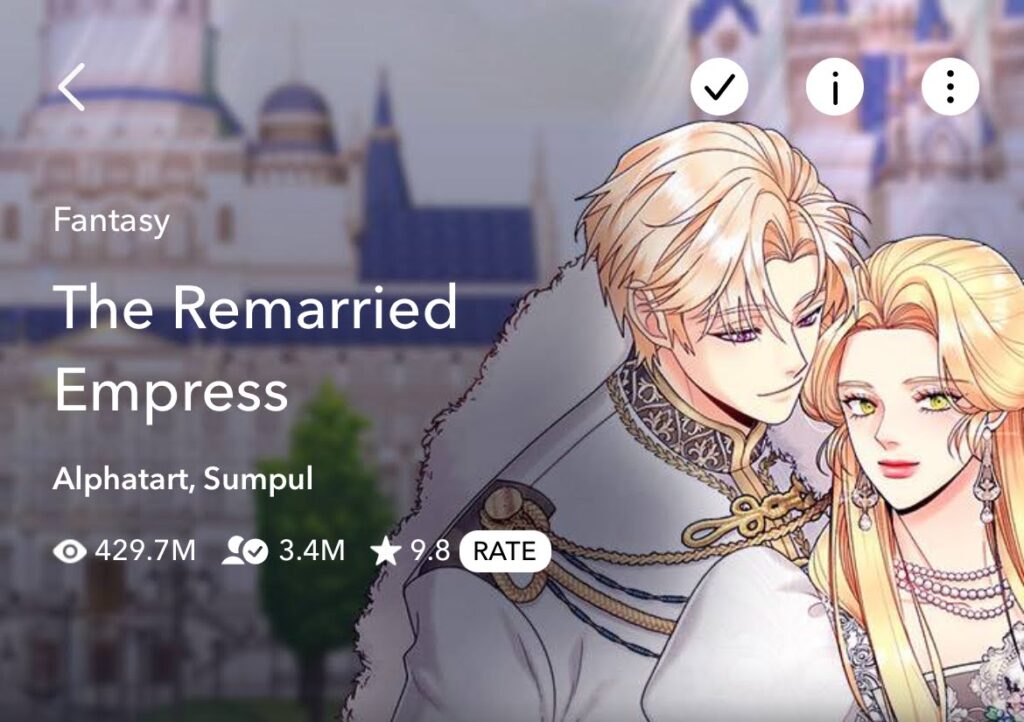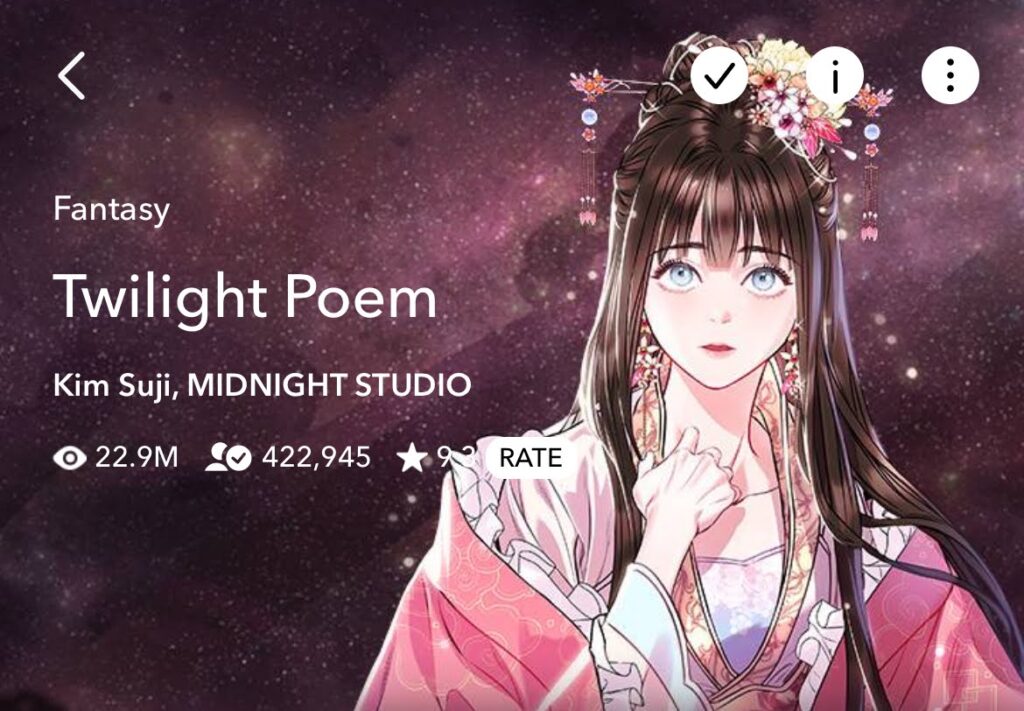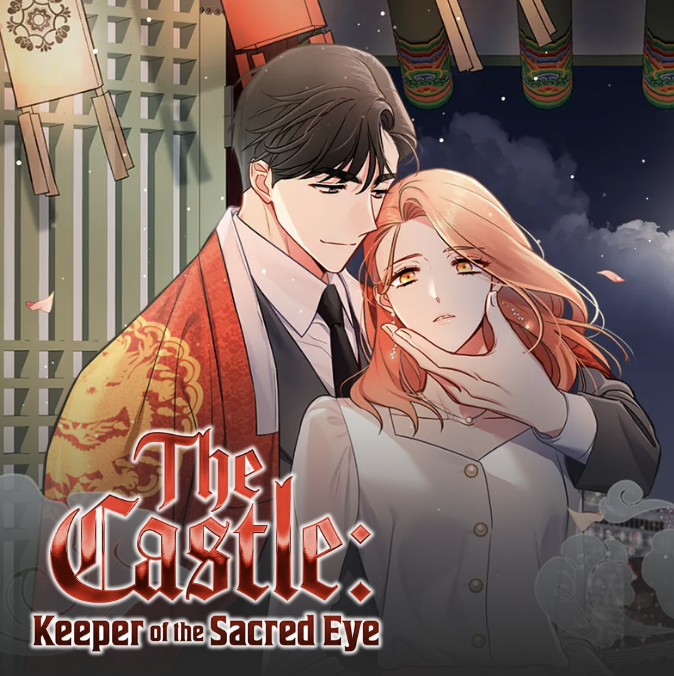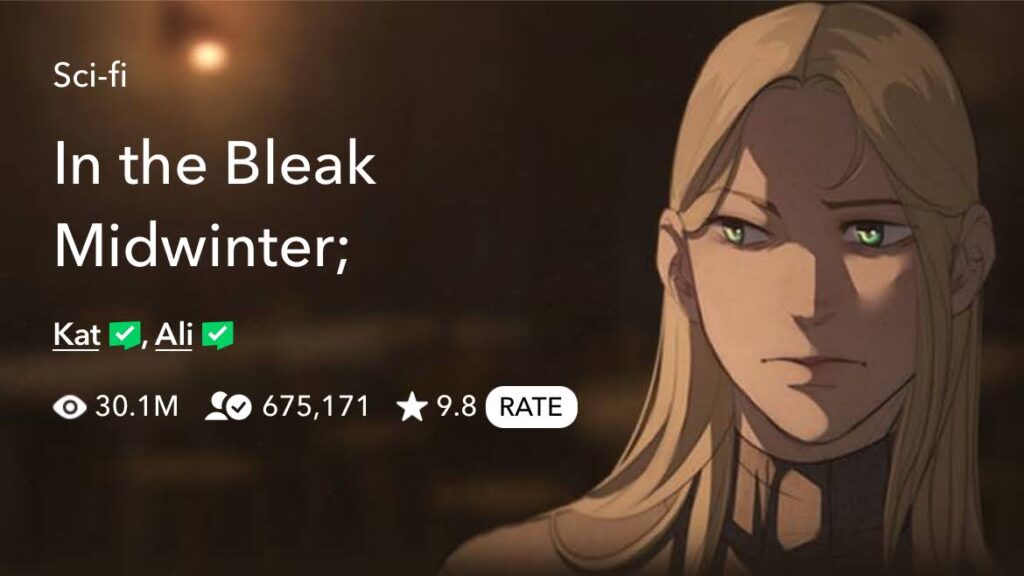The quality of the notifications on my phone has increased dramatically since I started buying manga/manhwa/comics on my phone.


Hints on how A.E. Graves spends her imaginary spare time
The quality of the notifications on my phone has increased dramatically since I started buying manga/manhwa/comics on my phone.


The Remarried Empress
by Alphatart, Sumpul
published by Webtoon (174 chapters, 3 seasons, ongoing)
2020 – present
While I am tired of reading about royalty, the fact that royalty are always at each others’ throats does make for light entertainment. [Sound] Oh, I meant in fiction. What? [Conversational sounds.] Yes, I suppose that’s also true in real life, but the characters are more compelling in fiction!
Navier grew up as the designated empress-to-be, and was childhood friends with emperor-to-be Sovieshu. They married, appeared to make a great couple, and Navier proved herself to be an effective empress, picking up Sovieshu’s slack. However, as the story opens, Sovieshu is demanding a divorce in favor of his childish mistress. Navier shocks everyone by not only accepting the divorce, but demanding remarriage to the emperor of a neighboring state, who makes an entrance and marries her on the spot!
How did we get here? That’s what the first two seasons set out to explain, while the third season proceeds once we’ve caught up.
This comic features: men who like their women childlike and dim; the stress of losing a not-great partner to a tantrum-throwing younger woman (I was going to joke that ‘we’ve all been there,’ but realized I have experienced this, and am unsure how to make it funny beyond assuring you that it is funny); blackmail; love potions that might work; pity; people who think power means being able to mutilate one’s own domestic staff; an empress who trained for one job her whole life, and isn’t sure how to pivot; divorce lawyers; love letters delivered by unusually clever birds — a reason not to EVER eat birds for dinner; secrets; regret; an attractive man with an improbably muscled torso standing in a fountain in a way that burns his likeness into Navier’s mind…
The art evolves over the course of the story in a way I like: the lines firm up in pleasing ways, so give it some time.
This is a story that teaches us to let go of partners who aren’t that nice to us, and let them reap what they sow; to accept flirty love letters from pretty birds, and flirt right back; to do right by people; not to harm the family members of journalists; to get to know friendly men who look amazing naked after you spy them in abandoned places; and to find a place that will appreciate your leadership.

Twilight Poem
by Kim Suji, MIDNIGHT STUDIO
published by Webtoon (69 chapters, complete)
2022-2024
This story has a controversial ending that set the comment pages afire.
What if… the angelic heroine of a story, who was abused terribly from infancy until the age of marriage, can’t stop crying? What if… the handsome, heroic male lead forced into marriage with the female lead is a self-absorbed jerk whose character growth heads in the right direction, but too slowly to benefit the female lead? What if… the villain is the only character who behaves consistently? What if all of this happened in a gorgeously drawn Chinese period costume drama?
THAT is this story!
Yes, female leads are usually perfect, and male leads usually grow up to be admirable human beings. That… just doesn’t happen here. The female lead is so busy weeping and trying to martyr herself that the male lead can’t even deal, terrible things happen as a result of his neglect, and then everyone makes bold choices accordingly.

I won’t post spoilers, but I think the ending was fine! Perfectly reasonable! MORE dramas should end this way!
(If this sort of thing amuses you, I encourage you to peruse the angry reader comments at the end. The best comment was a complaint from a botanist resolving a character disagreement on whether a valley had moss or flowers in it – HILARIOUS.)
The drawings are lovely, the glowing-lantern-filled scenery and palaces are well executed, the ribbon-style hair is shiny, the male lead looks like a face painted on a traditional kite when he is angry (which is most of the time)… I enjoyed that characters are flawed, I enjoyed not liking the characters, and I even enjoyed the fact that the ending is controversial to some readers.

I have been tired. So tired. How tired? I have been able to achieve REM sleep on public transit.
This is… worrisome.

I Tamed My Ex-husband’s Mad Dog
by CMJM, Jagae, Jkyum
published by Tappytoon (71 chapters, in season 3, ongoing)
2022 (?) – present
I didn’t expect to try to read all available chapters of this story in a few days, but it is fun enough that I didn’t want to put it down.
Reinhardt is a woman who has been wronged. She spent her youth engaged to the crown prince, only for him to send her father off to quell unrest the crown prince caused himself, get her father killed, and THEN call off the marriage and send her far away… Embittered, Reinhardt wishes for another chance – and when she gets it, and finds herself at her father’s casket 15 years in the past, she uses that chance to stab the crown prince in the leg with a sword in a way he’ll never recover from.
Her exile is harsher this time, but she is rescued from a mercenary by a feral boy – whom she recognizes as the crown prince’s henchman from the bitter version of her life. Perhaps she can raise this young version of Wilhelm in her exile to turn out differently. Perhaps he can be a tool of her revenge.
Or, as Will grows up into a powerful knight who is obsessed with her, perhaps he can be more than that – her partner or… her downfall.
Revenge is a tricky business, and one needs more than that to live a good life – as our characters discover! This story involves: speech therapy, loyal knights, daddy’s sword, stolen corpses, younger men, peat (no, seriously, peat), jealousy, teleportation crystals (!), empire-building, wars, love, obsession, annoying empresses, dungeons, capable female heads of state, wars, head injuries, male line verification science, fancy outfits, and lies… I’m very much in suspense in chapter 71, and am eager for more.

The Castle: Keeper of the Sacred Eye
by Jin Soye, hyeyong, pecan
published by Tappytoon (50 chapters ( 1 season), on hiatus / to be continued)
2023 (?) – present
Back in February, I summarized this comic as “contemporary imaginary Korean royalty battle evil spirits trapped in paintings through heterosexuality.” That is still a concise and funny summary, but I can do better… Maybe.
Jo Yuyeon is a redhead in a bad situation in contemporary Korea. She is indebted to her boss, who is keeping her comatose mother on life support in exchange for her complete devotion to running his businesses, while living in her boss’ home, and being an exploited girlfriend of the boss’ disagreeable son. A chance encounter with an evil spirit in a painting reveals that she has skills the Korean royal family needs – and she catches Prince Geon’s eye. Her adoptive family would rather get their spoiled daughter into the palace, and not give Yuyeon up. And the palace itself has a powerful spirit with its own opinion.
This has a story quite unlike the other comics I’m reading, and I have no idea how it will turn out. I want more contemporary Korean content, and so I’ll pick this up again in Season 2.

Like Wind on a Dry Branch
by Dalsaeowl, Hwaeum
published by Webtoon (ongoing, currently at chapter 177)
2021 – present
I’m 177 chapters into this enjoyable illustrated novel, and it isn’t going to end anytime soon, so I should review and recommend it! Admittedly, this one starts rough – the author notes that they like stories of overcoming adversity, and this one starts out ALL ABOUT ADVERSITY.
When we first meet our heroine, Rieta, she is sedated and being led to a graveyard to be buried alive by the man who sold her child into slavery… No, wait, come back! This would be a one issue comic if that played out – there’s more!
AHEM. Where was I? Rieta is saved from being buried alive by a prince with a bad reputation, but it turns out that is a front – there’s a lot more going on than appearances suggest. Prince Killian Axias pretends to be a playboy, but this masks the threat he poses to the current order. Rieta seems like a hapless commoner hollowed out by grief, but has healing powers beyond explanation, raising questions about how she flunked out of religious school. Plague is spreading strangely and with suspicious timing. Magic is real, and is the subject of religious training involving the state church AND ALSO demons. And there is a curse left by a dying princess, which the current royal family is desperate to lift.
While Rieta devotes herself to healing others, the situation around her shifts, clear threats to her life emerge, and new allies refuse to let her give up on living.
The story is engaging and unpredictable, despite themes in common with other manhwa I am reading, such as: secret ancestry, corrupt religious officials, murderous royals, demons with good hair who never skip chest day (or any other day) at the gym, a harem that is not what it appears, curses, and sweet women who can cure plagues. What sets it apart is that it is well written, illustrated in subdued tones, has an unexpectedly reasonable prince, and takes non-obvious plot turns.
Plus, there is a quirk to the illustrations, where side-eye (you know what this is, don’t make me look at you this specific way with scorn) is unduly dramatic, and this delights me.
If I look forward to more even 177 chapters in, it’s good!


In the Bleak Midwinter
by Kat, Ali
published by Webtoon (37 chapters, ongoing)
2020 – present
Finally, another sci-fi story! YAAAAAAY!
Anya decides to cryogenically sleep for a year to avoid processing grief for her mother and sister in android-related accidents, only to wake up 25 years later in a human-versus-android hellscape.
Worse, the digital readout on her wrist which was counting down the years and minutes until she meets her “soulmate” lights up when she leaves her cryo-pod and sees a man… who immediately shoots her dead.
What the hell? Well, that was a short review, onto the next… wait, she comes back to life? And multiple people are after her as an advantage they could use to win the war they’ve been waging while she slept?
Everyone has Russian names, it snows constantly, Anya has terrible nightmares, and her brother is still a jerk (because some things never change). The art is a mix of video-game textures, eerie lights with convincing halos, and characters that look best straight on or in full profile. I like the eeriness and ambiguity of the characters called The Ten, and Anya’s combination of being terrified yet also being willing to try very risky plans rather than watch other humans die.
Each episode has music, which adds to the mood (but you can keep it very low).
I’m delighted to find a sci-fi story on the Webtoon platform.
That’s a thing I should do… regularly. I am now vaguely familiar with what it means to be rested. It’s so… novel! So strange!
I posted a list of restaurants I like (despite being a gluten-free vegetarian) in Waikiki on my phone photo blog: you can find details by following the link.